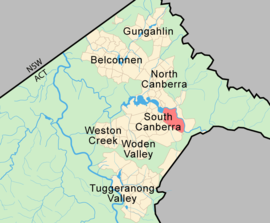Fyshwick, Australian Capital Territory
|
Fyshwick Canberra, Australian Capital Territory |
|||||||||||||
|---|---|---|---|---|---|---|---|---|---|---|---|---|---|
 |
|||||||||||||
| Population | 38 (2011 census) | ||||||||||||
| • Density | 3.89/km2 (10.08/sq mi) | ||||||||||||
| Gazetted | 20 September 1928 | ||||||||||||
| Postcode(s) | 2609 | ||||||||||||
| Area | 9.76 km2 (3.8 sq mi) | ||||||||||||
| District | South Canberra | ||||||||||||
| Territory electorate(s) | Kurrajong | ||||||||||||
| Federal Division(s) | Canberra | ||||||||||||
|
|||||||||||||
Fyshwick (postcode: 2609) is a retail and light industry suburb of Canberra and is located east of the South Canberra district. On Census night 2011, Fyshwick had a population of 38 people.
It has many motor vehicle dealers, stores selling home furnishings and hardware, and stores that sell goods wholesale. There are also some fast-food outlets.
It was named after Sir Philip Fysh, a Tasmanian politician who assisted in bringing about Australia's Federation. The suffix "wick", from Old English, means "dwelling place" – and, by extension, "village" or "district". Its streets are named after Australia's industrial towns and regions – for example, Mount Isa is represented by Isa Street and Townsville is represented by Townsville Street.
It is known for its adult entertainment industry. Fyshwick and Mitchell are the two places in the ACT where strip clubs and brothels may operate legally. Prostitution in the ACT was decriminalised in 1992 but strip clubs and brothels are restricted to those two suburbs.
The only railway line into Canberra runs through the middle of Fyshwick dividing the area into halves. Ipswich and Newcastle Streets as well as the Monaro Highway cross the railway line uniting both halves of Fyshwick.
The Fyshwick sewage treatment works was built in 1967 to treat waste water that could not easily be pumped to the other side of Canberra. It is now used to treat industrial waste water, which is then used to water the Duntroon grounds and golf course.
One noteworthy portion of Fyshwick, located between the railway line and Canberra Avenue, was built as an internment camp during early 1918. It was known as the Molonglo Internment Camp, although it was also referred to as a concentration camp. The site was intended to accommodate 3,500 German and Austrian nationals being expelled from China, however once the camp had been established in May 1918 these internees were no longer destined for Molonglo. Instead, the camp housed 150 internees transferred from the Bourke Camp in New South Wales. The camp was closed in late 1919 after the internees were deported to Germany. Most of the camp's building were sold off, with the remaining buildings being converted to house construction workers, some of whom were unemployed returned servicemen. Gradually the camp buildings were moved to other camp sites around Canberra and the roads used to service the camp became the first streets of Fyshwick.
...
Wikipedia
